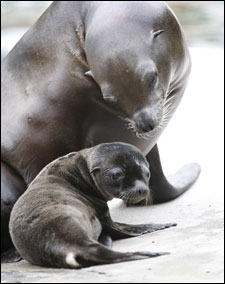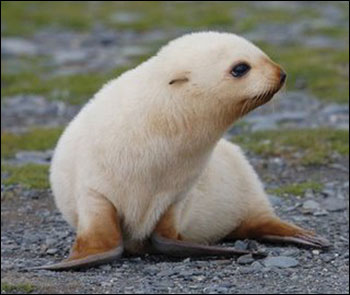|
Nature trail
Seals:

The animal we introduce you to today is the seal. There are several
species of seal that many people are not aware of. They are mostly found
in the colder continents like Antarctica, but there are also seals in
Europe and America. They look like little bears and the baby seals are
white and furry. They cannot be found in Sri Lanka except at the
Dehiwala Zoo.And that too only species like sea lions.
These large aquatic mammals are distinguished by their four legs
which have been fully adapted into flippers.
While the limbs of seals have developed into flippers, the tail has
practically disappeared, making seals different from other marine
mammals, such as whales, dugongs, and manatees, which have lost their
hind legs and use their powerful tails for swimming.
On land, sea lions, fur seals, and walruses use their large flippers
back and forth to act as legs, allowing them to walk clumsily on land or
ice. The short flippers of true seals do not turn under the body to act
as legs. These seals move on land mainly by flexing their bodies,
although on snow and ice they can also use their fore flippers as
paddles to reach amazing speeds. The crabeater seal, for example, can
cruise at 25 km/h (16 mph) on level Antarctic ice.
 There
are three families of seals; the true seals (phocidae), the eared seals
(Otariidae), and the walrus (Odobenidae). There
are three families of seals; the true seals (phocidae), the eared seals
(Otariidae), and the walrus (Odobenidae).
Although similar in appearance, it is easy to tell the difference
between eared seals (sea lions and fur seals), true seals, and walruses.
Sea lions and fur seals have tiny external ears while only the ear
openings are visible in true seals and walruses.
True seals lack outside ears and have short flippers that are nearly
useless for walking on land, so they are dragged behind the body in
strange snake-like movements. The eared seals, including the sea lions
and fur seals, have tiny external ears and can lift their bodies off the
ground with their flippers. They can move fast, both on and off land.
The stout-bodied walrus, with its wrinkled skin and unique tusks, is the
only member of its family.
In addition to their flippered limbs, seals have streamlined and
flexible bodies, adaptations that make them excellent and efficient
swimmers. Sea lions are the fastest seals and can swim at top speeds of
nearly 40 km/h (25 mph). These seals are so flexible that they can
nearly touch their rear flippers with their nose when bending backward.
Seals range in size from the male southern elephant seal, which
reaches more than 3600 kg (8000 lb) in weight, and the male walrus,
which grow to more than 3.5 m (11.5 ft) in length and reaches weights of
over 1700 kg (3700 lb), to the small ringed seal with adults averaging
about 50 to 60 kg (about 110 to 130 lb) and a little more than 1 m (3
ft) in length.
As seals spend most of their time in water they are not only
excellent swimmers but also good divers. Seals react and adapt to water
in many ways. Ears are greatly reduced in size, in appearance.
When seals are underwater their nostrils close automatically. The
pupils of their eyes expand widely to capture light in near darkness.
This ability is important for hunting at night or in deep water.The
deepest-diving seals can dive hundreds of metres and stay underwater for
one to two hours.
During a dive, carbon dioxide builds up in the blood and the loss of
oxygen causes lactic acid levels to rise in the muscles. Unlike most
animals, seals are able to resist pain and fatigue caused by lactic acid
accumulation. But once seals return to the water surface, they need a
recovery period to bring their body chemistry back to normal. Rapid
blood circulation through very large veins leading to the lungs helps to
rid the seal's body of carbon dioxide. The big-branched veins carrying
blood out of the walrus' lower body are so large that a person could
pull them over their legs like pants. Keeping warm is important for
seals since water quickly takes heat away from their bodies. Adult seals
produce a thick layer of fat, called blubber, under their skin, which is
an excellent insulator against the cold. Blubber is also used to store
energy for times when food is scarce; seals can live off the stored fat
in blubber for weeks to months. While most newborn seals have little or
no blubber, many seal species develop a fur coat during infancy that
traps air next to the skin for an extra layer of insulation (warmth).
Many species shed this fur coat as they grow older, replacing it with
blubber for insulation. Fur seals, however, keep a thick coat of fur
throughout their lives, made up of about 120,000 hairs per sq cm (about
800,000 hairs per sq in). By contrast, an entire human head contains
only about 100,000 hairs.
Seals make and hear sounds underwater. Their whoops, screams, barks,
moans, and wails are used in simple communication, such as mating calls
and territorial defense.
Some species, including bearded seals, Weddell seals, and walruses,
sing complex songs that may last more than a minute. It is still unknown
if seals use reflected underwater sound waves or echolocation, to
navigate through the depths or to track prey.
Most seals eat fish and sometimes squid. The leopard seal, an
Antarctic species, may have the most diverse diet of all, commonly
hunting penguins and other seabirds, smaller seals, such as the
crabeater and ross seals, fish, squid, krill (small shrimplike
crustaceans), and other invertebrates. They also feed on bodies of dead
whales. Leopard seals sometimes hunt humans, lunging onto ice floes to
chase people who are on foot, and also threatening scuba divers
underwater. The South American Sea Lion also eats penguins as well as
flying seabirds and young South American Fur Seals. Arctic species are
an important component of the polar bear diet. Almost all pinnipeds
(seals) are potential prey for orcas.
Sea lions and walruses may sometimes kill and eat other seals,
although sea lions more commonly eat fish, and walruses dive to the
bottom and dig for clams, worms, crustaceans, and other life from the
mud.
Walruses have a large moustache of especially sensitive whiskers,
which help them detect their food on the dark sea floor.A big walrus can
eat about 45 kg (about 100 lb) of shellfish in one day.Crabeater seals
of the Antarctic are known to eat fish, but are unusual because they eat
with teeth that are unique for hunting krill.(tiny fish).The seal's
upper and lower teeth mesh together, forming an efficient filter that
acts similarly to the giant filtering plates of baleen( whale bone)
found in krill-eating whales.
Females give birth out of the water.Most females breed every year and
on average bear a single pup (or calf in the case of walruses).
They do not give birth until 3-5 months after conception, when food
is plentiful. Newborn seals vary in size according to species. A newborn
ringed seal weighs only 12 kg (25 lb) while a newborn walrus can weigh
63 kg (140 lb). Young seals grow very fast, and quickly build up a layer
of blubber that they don't have when they are born.
Females nurse young from a few days, to a few years, depending on the
species. The hooded seal nurses for only three to five days and the pups
nearly double their weight from 22 to 43 kg (49 to 95 lb) in this time.
But sea lions, fur seals, and walruses, continue to nurse their young
for one to two years.
Seal milk is extremely rich and carries a lot of fat and protein.
True seals have the highest milk fat levels, averaging 40 to 50 per
cent, while sea lions and fur seals pack 10 to 14 percent protein into
their milk. Elephant seal milk is tasteless and looks like melted
vanilla ice cream.
In most land-breeding seals, such as elephant seals and sea lions,
dense temporary colonies called rookeries are formed in the breeding
season. In these species, males tend to grow larger than females, and a
harem system prevails in which the strongest males has several females
and guard them from other males. The reproductive behaviour of walruses
and many other true seals are generally less well-known. These species,
including ribbon seals, harp seals, and Weddell seals, form colonies
that spread out over wide areas.
Most ice-breeding species are monogamous, (married) and the males and
females are nearly the same in size and appearance. An exception is the
walrus, which breeds on ice islands where large dominant males gather
sizeable harems.
Walruses use their tusks in threatening displays toward rival males
and in courtship rituals with females. Males have large throat pouches
that produce bell-like sounds to attract receptive females.
Natural predators of seals include large sharks, especially the great
white shark, the orca, or killer whale, and other seals such as the
leopard seal. Polar bears skill seals on land and ice in the Arctic.
There are even reports of eagle attacks on baby Caspian seals. But the
greatest menace to seals are humans, who hunt seals for food, seal skins
used for clothing, and even housing and small boats.
This became a profitable business in Europe and in the 1700s. Like
whales, seals were hunted for their blubber, which was converted to oil
for fuel, lubrication, and tanning.Today seals are still killed for
their skins in some countries, such as Canada and Russia. Because of
this, the northern elephant seal became nearly extinct.
Hawaiian and Mediterranean monk seals live along warm shores and are
very easy to hunt. Both monk seal species are currently endangered. A
third monk seal, which once lived in great numbers in the Caribbean,
became extinct by about 1950.The United States, Canada, Russia, and
Japan agreed to ban open-sea hunting of seals in 1911. After Mexico
banned seal hunting in 1922, the northern elephant seal population began
to grow.
In 1910, only 100 seals were found on Isla de Guadalupe; today this
species numbers around 150,000 and has gained much of its former range
from northern Mexico to southern Alaska.However, another species, the
Guadalupe fur seal, hunted during the same period, has not recovered its
former numbers along the California and Mexican coasts. Even though seal
hunting has reduced, oil
spills and pollution kills many seals throughout the year.
- Shalindri Perera
Pix: Internet
*********
Did You know ?
* Each year, hundreds of thousands of baby harp seals are slaughtered
on the ice fields off Canada's east coast for their pelts. Over 95 per
cent of the seals killed during this hunt are just days or weeks old.
* There are more than 30 species of seal in the world.
* Seals evolved from bears in the arctic.
* Seals can stay underwater for over two hours at a time.

* Male seals are called bulls and females are called cows.
* Seals have sharp teeth which are used for tearing their prey
* The most common seals are:
- Walrus - Odobenus rosmarus
- The Common Seal (grey/harbor seal)-phocidae
- The Weddell Seal-Leptonychotes weddellii
- The Ross Seal-Ommatophoca rossi
- Crabeater Seal-Lobodon carcinophagus
- Leopard Seal-Hydrurga leptonyx
- Northern Elephant Seal- Mirounga
angustirostris
- Antarctic Fur Seal- gazella
********* |

